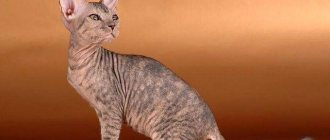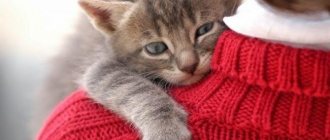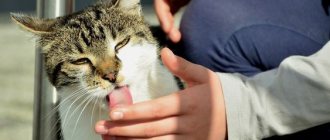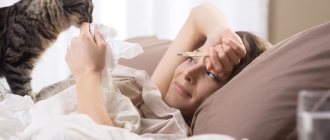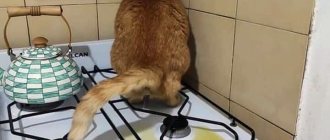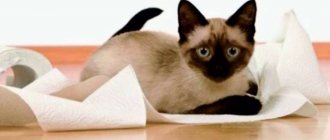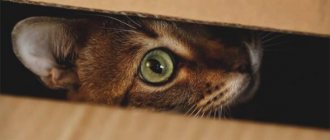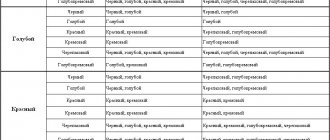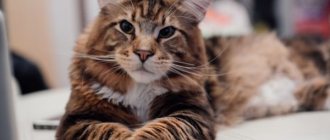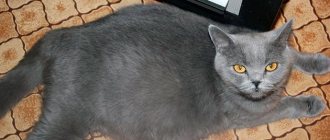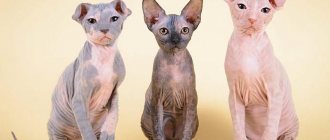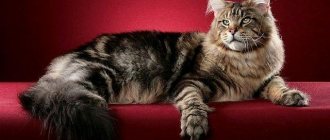Among the many different breeds, the mestizo cat has always been a leader in popularity and prevalence. A mixed breed is a cross between several cat breeds, as a result of which the kitten inherits the best traits of its parents along with its genes. The mixed-breed cat is distinguished by good health, a kind and flexible character, and a beautiful and unusual appearance.
Mixed cat, what does it mean?
Metis is not a cat breed. Such animals appear in a parent couple, where one is a representative of an elite breed, and the second is outbred. Another option is possible - when both parents are elite, but belong to different breeds. Crossing between them is allowed, and the litter acquires the qualities of the parent pair and is able to continue the race.
There is another concept - a cat hybrid. This means that individuals from different branches of the biological tree participated in the crossing. For example, a caracal from the Moscow Zoo mated with an ordinary cat, which subsequently gave birth to a healthy large kitten.
This event became a sensation in world felinology and forced a new look at the process of breeding hybrid cats. Thus, the Chausie breed appeared - a hybrid of the wild jungle cat Felis Chaus and the Abyssinian cat, and the Savannah - a mestizo cat bred by mating an African serval and a bengal.
Origin story
The Siberian breed has a long history, but how it originated is not known for certain. Some experts believe that the ancestor of the breed is the Norwegian forest cat, brought to Russia in the 16th century. According to another version, “Siberians” descended from Bukhara cats brought by Central Asian merchants.
Only one thing is known for sure: once on the territory of Siberia, the imported cats adapted to the cold, acquired thick fur, and became dexterous hunters of small game.
Interesting! Siberian cats resemble Pallas' cats in appearance. Therefore, there is an uncommon assumption that representatives of the breed originated from these wild animals.
In the 18th–19th centuries, “Siberians” spread throughout Russia and became the most popular cats of local origin. But breed standards took shape only in the 1980s, when breeding began. Standardizing the breed turned out to be difficult, since in different regions of the country cats had their own external characteristics.
In 1991, the Siberian cat breed was registered by the World Feline Federation. A few years later, the breed has already gained popularity in many countries.
Advantages and disadvantages of mestizo
According to official data, there are 250 registered cat breeds. The total number of cats living throughout the globe is about half a billion. In addition to officially recognized breeds, there are also stray animals that are not included in the statistics. Random mating results in a huge population of mestizos. Whether this is good or bad is difficult to say, but we have identified several advantages and disadvantages of being mestizos.
Let's start with the pros:
- In the first generation, mixed-breed kittens receive the best characteristics of the parent pair, but later, unfortunately, they lose them.
- Mixed breeds are often healthy, but if one or both parents have an altered genotype, the kittens are more likely to be born sick.
- By purposefully crossing several breeds, it is possible to obtain an animal with a certain set of external qualities.
- The character also determines the genotype of the parental pair. A pampered Persian cat and a calm mongrel cat will not produce aggressive kittens.
As for the disadvantages, there are few of them - keeping a mestizo in the house is neither prestigious nor profitable.
Half-breeds do not have the right to participate in exhibitions, do not have a pedigree, are not allowed to crossbreed with elite animals, and there is no queue of people who want to get a purebred pet. However, cat lovers in most cases do not pay attention to such nuances and happily take outbred animals from the shelter.
How to choose?
Mixed-breed cats are sold everywhere. In order not to make a mistake when choosing a pet, it is useful to familiarize yourself with the following recommendations:
- Look at the mother, ask what cats were crossed with.
- Ask about the character of the parents, the presence of any special features.
- Ask about preventive vaccination and whether you have been examined by a veterinarian.
- It is better not to adopt obstinate kittens. If they scratch and hiss from childhood, there is a high probability that at an older age the individuals will be aggressive and unyielding.
When choosing a small pet, you need it to look healthy in appearance.
In addition to recommendations, it is worth paying attention to the appearance of the animal. If the cat has no health problems, he will have clean, shiny and smooth fur, clear eyes, an energetic character and curiosity. It is important to look at the belly; it should not be swollen, otherwise there is a risk of the kitten becoming infected with parasites or developing intestinal diseases.
Metis with British
The British cat is an indigenous breed with an ancient history of development, which begins in the days of the Roman legionnaires. These animals are endowed with refined manners, prefer solitude, do not like noisy companies and too active games. The most common crosses of British cats are with ordinary cats, with Toygers and with Siamese.
A mix of a British cat and a regular cat
Outbred cats have an amazing ability to quickly adapt to their environment. These animals are independent, unpretentious, endowed with excellent hunting skills that allow them not to die of hunger, which cannot be said about most purebred domestic cats.
It is worth noting that street cats do not strive for privacy; they are sociable and do not mind contact with people if they behave kindly. Animals that are brought into the home at an early age are socialized no worse than purebred cats.
Mixed breeds of a British cat and a regular one are most common. Sometimes at first glance it is even difficult to distinguish who is who. Half-breeds have the same massive bone structure and broad chest, but are slightly smaller in size. Developed cheeks make the muzzle round.
Coat colors are varied. The British are characterized by about 200 colors, so the color options for mixed breeds are unlimited. There are individuals with a color-point mask like the Siamese or spectacular silver chinchilla ticking.
The Métis partly adopt the British desire for privacy. Such animals are more eager to be the center of attention; they are quite sociable and responsive.
Interesting. At an early age, half-breeds exhibit to a greater extent the manners of mongrel animals, and in adulthood they show prudence and sedateness - qualities inherent in the British breed.
Toyger/British mix
Mixed Toyger + British cat is an animal with a clear striped pattern on its fur. The Toyger breed was developed relatively recently and received admission to the exhibition career in 2007. These cats are characterized by the only so-called brindle color.
Toygers are much thinner than the British, have an elongated body and long legs. Mestizos are distinguished by an average constitution, proportional physique, and a beautiful fur coat with a tabba pattern. The bands may be clear or blurred, but are present in 95% of cases.
The character of half-breeds is more reminiscent of the British. They are just as prim and calm. Second-generation mestizos resemble only one of their parents.
Mix of Siamese and British cat
Mixed breeds of British and Siamese cats are spectacular beauties with a solid color, for which the C gene is responsible, which is involved in the formation of the color point color.
The Siamese color depends on the animal's body temperature. The body of cats is warmer, so the gene does not appear in this part of the body. The fur on the body is always light. The limbs, ears, muzzle and tail are cooler, so the coat is darker in these areas. The British are also characterized by the Siamese color, which is inherited.
A cross between a Siamese and a Briton looks heavy, has a massive bone structure and a wide chest, long legs and a tail.
Kittens inherit an independent character and egocentrism (from the British), resentment and rancor (from the Siamese). The British genotype is considered dominant, which is often expressed in complete resemblance to the aristocratic breed.
You can buy a British kitten from us. Minsk. +375 (29, 44) 7-222-444
If you have decided to get yourself a kitten and, while browsing the Internet, you don’t know the difference between a British kitten and an ordinary kitten, this article is for you. Looking at a kitten as a whole, it is not always clear how purebred the animal is. Details matter here.
It is in professional nurseries that the kitten and its standards are carefully and carefully studied. Additionally, at the age of about 2 months, kittens are brought to the club for a full examination of the animals and their selection for the breed.
Any nursery will be able to provide you with documents confirming the purebred of the animal - metrics, pedigree of the kitten and its parents. If a breeder offers you to purchase an animal without documents, the question of its origin 100% arises. Since interbreed matings are prohibited and no phenological organization will issue documents for such a litter of kittens. Therefore, those who often sell “purebred and purebred” kittens without documents at a cheaper price offer mestizos.
HOW MUCH DO THE DOCUMENTS COST? WHY OVERPAY?
Real purebred kittens that have been checked by a veterinarian and a breed expert at the club are issued documents. If the kitten is healthy physically, genetically, and there are no deviations in psychological health, a document is issued for it and an identification number is assigned (it is not repeated anywhere else in the world). And the documents themselves are worth nothing.
If the animal with documents is a purebred animal
If without documents - perhaps mestizos, marriages due to health reasons, injuries, incorrect matings, mongrel animals
You should be alarmed by the information that documents were not issued for the kitten. What's the matter? Is the kitten out of breed? Does your kitten have health problems? He cannot relate to the breed due to his unhealthy psyche and deformities? Be careful. Let's make a reservation once again - documents cost nothing . Documents are issued only for healthy and purebred animals!
WHERE TO FIND A PEDIGREE ANIMAL?
In the nursery. And only in the nursery.
When buying an animal at the market, you need to understand that a real breeder of the British breed will never take his pets there. But mestizos are most often sold there. The worst thing is not buying a kitten at the market, it’s worse when the animal may show hidden diseases or genetic problems; hundreds of people pass by at the market and everyone tries to touch the kitten with dirty hands. Let’s not even talk about the stress the poor animals get from such a pastime.
And if you buy a kitten on the market, you won’t be able to find such “breeders” during the day and won’t hold them accountable. You won’t believe the lengths to which they sometimes resort to passing off an ordinary kitten as a British one. They can even be painted with paints. And this is the lesser of the evils. What we haven’t seen in practice...
It would be much better to find a nursery or breeder who specializes in the British breed. View the pedigrees of the parents. In the pedigree, you will see the BRI/BRL coding for parents, grandmothers and great-grandmothers - British breed.
Don’t rush, even if you want to bring your baby home sooner, for example, at one and a half months. A good breeder will not want to give you his kittens before 3-4 months. If, on the contrary, you are offered to pick up the kitten earlier, pay attention to this. Up to 3-4 months, babies still eat their mother's milk, learn to go to the tray, serve, wash themselves, and get used to the scratching post. The kitten’s psyche is also formed.
Maine Coon mixes
The Maine Coon is a large-sized native cat breed. The animals are distinguished by their massive build, strong bones, angular contoured muzzle, and large ears with tufts. Colors can be any: cinnamon, lilac, chocolate and fawn, solid.
The coat is thick, water-repellent, and the undercoat is soft. The neck is decorated with a frill. The tail is long, wide at the base, tapering to the tip, covered with long hair. The eyes are oval, expressive, the color of the iris matches the color of the coat.
Breeding Maine Coon mestizos is officially prohibited, but in reality this issue is not controlled. Amateur breeders often breed Maine Coons with other cat breeds. Half-breeds are much cheaper, which increases the demand for them.
In specialized nurseries, cull cats are not sold for breeding, but they can be purchased as a pet. Such animals must be castrated or sterilized.
It is also important to remember that a purebred Maine Coon and a mixed breed are completely different animals. A half-breed will never meet the breed standard. The appearance of such cats is very diverse and depends on the genotype of the parents.
Purebred Maine Coons are endowed with the following qualities:
- goodwill;
- agreeableness;
- sociability;
- devotion;
- prudence.
When crossed with a regular cat, these traits change or disappear completely.
As for external qualities, purebreds must have tufted ears, an elongated muzzle, massive paws, and a long fluffy tail. Three-month-old kittens should weigh at least 2.5 kg (the cubs of an ordinary cat at this age weigh no more than 1 kg). The body length of adult males is approximately 1 m and weight is 11 kg.
As for attempts to crossbreed the Maine Coon with other breeds, they all failed. The purpose of such experiments was the desire to add some qualities from other breeds to Maine Coons. For example, to produce a big cat of an unusual color, a female Maine Coon was bred with a male Siamese breed. However, the experiment was unsuccessful - kittens of different sizes were born in the litter.
When mated with Persians, the result was large kittens with fluffy red fur without the slightest hint of resemblance to Maine Coons. An attempt to crossbreed with a Bengal to increase body size also failed.
Maine Coon and Siberian kittens are similar in appearance to purebreds, but are of medium size. Such babies are often passed off as noble, but they are sold at a discount and without a pedigree.
A mixed breed of a Maine Coon and a domestic cat was obtained completely by accident. The baby retained the color of his coat, but lost a number of positive character traits.
Maine Coons are also crossed with Britons, Neva Masquerade and other breeds of cats, producing litters with fur of different lengths.
Possible offspring
No significant changes are expected in terms of coat color. Most domestic cats without admixture from other breeds have the colors acceptable in Maine Coon Cats. But genetics suggests unexpected results. Mutations, such as polydactyly, which is common in coons, are likely to affect part of the litter. Coat color and pattern are inherited according to established laws.
Science knows interesting facts about eye color. Usually it does not depend on the color of the coat, but blue pigment accompanies color-point colors (Siamese cats), and less often white. In practice, if you cross a green-eyed coon with a blue-eyed female, the offspring will most likely take after the father for this trait. This happens because green is dominant to blue. When white kittens are born, the situation may change.
All Maine Coon cats have medium-length fur. If you cross a representative with a smooth cat, the litter will be short-haired. The birth of kittens with long hair is possible if there are two long-haired parents.
Character and behavior are unpredictable in this combination. Street cats are more aggressive by nature, this is dictated by the laws of survival in difficult conditions. Pedigree cats are softer, because purposeful work has been carried out for decades to consolidate behavior that is comfortable for humans.
Weight and body structure are also difficult to calculate, but most half-breeds are distinguished by their impressive dimensions, although they are inferior to their purebred parents. Kittens are born with different characteristics, some are smaller, some are larger.
Metis requires the same careful attention as a purebred animal. A balanced diet, walks, and the love of the owner are mandatory criteria for the happiness of any pet.
Mixed bengal cat
The Bengal cat is a cross between a domestic cat and an Asian leopard. Mating Bengals with other breeds is prohibited by all felinological organizations. There are no recognized crossbreeds of this breed, but this does not prevent unscrupulous breeders from crossing Bengals with other breeds or ordinary cats. As a result, mestizos with a variety of colors appear. The second generation completely loses the characteristics of its parents.
Recently, long-haired Bengals have become especially popular; they retain the characteristics of the breed, but have long hair, a fluffy collar and tail.
If earlier breeders sterilized such animals, now the long-haired variety is valued higher than the traditional Bengal cat.
Differences between adults and ordinary people
Among other representatives of the cat family, the Maine Coon stands out, first of all, for its size. These are large cats, they have powerful paws, a strong musculoskeletal system, and even a larger muzzle than other members of the cat family. Secondly, his habits give him away - self-esteem, pride. Taken together, these features resemble wild royalty. What to pay attention to when in doubt:
- The purebred pet has a “box” muzzle and slanted eyes. Simple cats have round eyes, their muzzle is either triangular or round, and there is no characteristic shape.
- Another feature is that the ears are pointed and topped with original tassels. Domestic cats cannot boast of such an appearance.
- Maine Coons reach a weight of 8 to 10 kilograms. An ordinary adult cat will weigh no more than 5 - 6 kilograms. An adult cat of noble blood, even at first glance, will seem large, heavy, and impressive.
- You can distinguish a domestic cat by the degree of vegetation. The fur on the face and paws of pedigree cats will be thick and short, becoming longer towards the back and sides, forming a fluffy collar and a kind of mane, and there are pronounced “pants” on the hind legs. In simple cats, the hair is usually uniform - either short or elongated - with undercoat.
- Another sign of pride for feline aristocrats is a luxurious tail. It is unusually (unlike all other breeds) fluffy, spreading, reaching a length of 45 to 60 cm. In simple animals, tails usually do not grow longer than thirty centimeters.
To be sure to understand where an adult Maine Coon is and where an ordinary cat is, you must study the breed from photographs. When the eye is “observed”, the differences will immediately catch the eye.
Maine Coons are distinguished by their character and habits. These are independent, humane animals. They resemble dogs in character. They love to play with water, splashing it out of a bowl or with a stream from the tap, and bathe with pleasure. They have a high level of intelligence and are easy to train. The owners of these cats constantly hear their voice - they purr, meow, purr, rumble, and accompany their actions with sounds. Moreover, their high tone does not at all correspond to their respectable appearance. Maine Coons have a melodic and even squeaky voice.
Maine - Coon cats will be larger than cats as adults.
Persian cat mixes
The Persian cat is one of the most popular breeds in the world. The variability of colors is amazing; in this regard, Persians have no equal. In this regard, the number of Persian cat mestizos is growing steadily. The most widespread is the cross between the Persian and the British. Mixes of an ordinary cat and a Persian are often found. Of particular value are the Scottish Fold and Persian half-breeds.
Persian cats are often used to develop new breeds. One of these is an exotic cat. Externally, the exotic resembles a Persian, but has short hair.
Other famous breeds derived from the Persian cat:
- Napoleon - a mixture of a Persian and a Munchkin;
- Himalayan - a cross between a Persian and a Siamese;
- Cherub - a curly-haired Selkirk Rex with the face of a Persian cat;
- Tiffany - a mix with a Burmese, with an unusually soft and silky coat;
- The Alaskan Snow Cat is a cross between a Somali and a White Persian.
Reference. Interspecific crossing does not affect the health of mixed-breed Persians and other cats, except for the risk of genetic diseases.
Best breeds
Obviously, not all cat breeds correspond to the hunting description given above. In addition, it is rare that any breed includes all characteristics without exception. At the same time, there are certain types of four-legged furry pets that cope better than others with catching rodents. Let's look at the main ones.
Maine Coon
The breeding of such a breed is largely due to the presence of hunting skills in the animals. Initially, they served as a kind of hunters, protecting grain warehouses from unwanted attacks by rodents.
Representatives of the Maine Coon breed are distinguished by a high level of mobility. In addition, they are resistant to external environmental conditions, so they can hunt rodents in any weather. Animals are also distinguished by a certain excitement: when they see a mouse, they will watch and track it for a long time - until they catch it.
Another important characteristic of the breed is the fact that its representatives have quite impressive sizes. In this regard, they are able to catch even large rats
Russian blue
Smoky-colored cats have an absolute advantage - they are able to move smoothly, but at the same time quickly and silently, thanks to which they take their prey by surprise. The Russian Blue breed is a classic example of rat-catching cats. This is stated not only by scientific research and theorists, but also by experienced breeders.
Siberian
If we characterize the process of catching rodents performed by Siberian cats, then first of all two terms should be mentioned: quickly and quietly. Help in the capture process is provided by the features of the animal’s anatomical structure, namely: the presence of fluff and fur on the paw pads, which insulate sound as the furry pet moves.
READ Bowls and feeders for cats: what to choose
Representatives of the Siberian breed show great passion for catching rodents, and are also little attached to the owner. This is why you will more often find an animal hunting than lying in your arms.
Kurilian Bobtail
There is a widespread belief among breeders that animals of this breed have a character and behavior that is similar to the habits of dogs. Moreover, such characteristics appear in cats from childhood: they quickly become attached to their owners and fiercely protect them from any dangers and threats.
Thanks to the anatomical structure of the body, in particular, powerful paws, the animal can develop quite high speeds and also make long-distance jumps, which greatly simplifies the capture process for them.
Cymric
A cat of this breed prefers to live in private houses that have a local area, as he needs constant walks and active pastime. Representatives of the breed have quite dexterous and mobile paws, as well as tenacious claws, thanks to which they are able to catch rodents.
We choose by appearance and character
Every cat is unique. However, experts say that a pet’s character and susceptibility to diseases can be predicted by its external features. Mixed breeds of elite cats inherit the exterior and temperament that are characteristic of a particular breed. When choosing a mestizo, pay attention to the phenotype.
"Marquise" phenotype
Such animals are characterized by the following features: short black hair with white spots, a dense body constitution in males, and graceful in females. The phenotype is most often found in short-haired European breeds. Such animals have a stable and quite predictable character. Cats clearly demonstrate their intentions and achieve what they want with perseverance and affection.
Phenotype "Siberian cat"
This phenotype is characterized by a gray color and striped pattern, long hair and thick undercoat, a loose or dense body, a large head, and an elongated muzzle. Character is independent, self-sufficient. These cats walk on their own, define the role of the owner and make it clear what place they occupy in the house. They accept affection at will or according to their mood; they do not like calf tenderness.
Angora cat phenotype
Representatives of this phenotype are distinguished by long or semi-long hair of light shades, have a dry body, and an elegant head. Despite their independent disposition, cats are immensely loyal to their owner, however, sensing a person’s weakness, they are capable of showing aggression. Animals need constant contact with a person from whom they expect stability.
Phenotype "Persian cat"
These animals have long, silky hair without coarse guard hairs, a round head and flattened nose, and a loose or coarse body constitution. Cats demonstrate an independent character, consider themselves the main decoration of the house, and are often capricious. Mixed breeds are often cut like a lion, which makes it easier to care for their long hair.
Phenotype "oriental cat"
These cats are born with short hair, thin and dense bones, developed muscles, and large mobile ears. With an elegant appearance, representatives of this phenotype are quite heavy. Various colors: solid, spotted, striped, tabby, color point. Cats are human-oriented and have a need for regular communication, which is why they received the nickname “cat-dog.” Animals are very energetic, need active games, and try to establish their own rules in the house.
Phenotype "Thai cat"
Representatives of the phenotype have semi-long or short hair. Colors: lilac tabby point, blue point, seal point, lilac point. The color of the iris is exclusively blue. The constitution is dense, but not rough. The character is balanced, calm, non-conflict. The behavior pattern resembles that of a dog. Cats sense their owner's mood swings and are very persistent in achieving goals. They achieve their goals with persistence and affection.
"British" phenotype
This phenotype is characterized by dense and short fur, a round head, erect ears, a rough constitution, and a thick tail with stripes. Common colors are tabby and blue-gray. The character of these animals is independent and stubborn. When achieving what they want, they often show aggression; they do not like to sit on their owner’s lap; they allow themselves to be petted if they are in the mood, otherwise it is better not to approach.
Description
The Siamese cat's homeland was ancient Siam (modern Thailand), where they were considered sacred animals. This breed was kept only by royalty, whose children could not play with their peers. Siamese cats were companions and playmates for them.
These animals were prohibited from being exported from the country under penalty of death, so the world did not know about them until the 19th century. In the 70s of the 19th century, the ruler of Siam gave a couple of animals to the English royal family.
Already in 1872, the first representatives of this breed participated in exhibitions. A little later, in 1892, standards were drawn up for them that allowed for a kink in the tip of the tail, a rounded head and a slight squint. In 1902, the standards were changed; the usual characteristics of the breed were now considered defects.
Siamese cats came to Russia at the beginning of the twentieth century. The ruler of Siam gave several kittens to Nicholas II. Animals of modern standards (with a wedge-shaped head) were brought to the USSR in the 80s of the last century.
Appearance
Today, the Siamese cat breed has spread widely in our country, but it is often confused with the Thai population. Representatives of both groups have a characteristic color: a dark muzzle and limbs on a light body, but at the same time they look completely different. To make the differences clearer, let's first look at what real Siamese look like.
Externally, the cat looks elegant and graceful. It has a slender, wedge-shaped head with black, pointed ears. Deep blue almond-shaped eyes look serious and meaningful. The body appears graceful and fragile, but in fact has strong muscles. The limbs are thin, the front legs are shorter than the hind legs. The tail is thin, like a whip. Weight is balanced, girls weigh 4-5 kg, boys - 5-6 kg.
There is a black mask on the cat's face, and the same color on the paws and tail.
Kittens are born completely white. Their black fur grows later, so the delicate pink skin shows through in the places where it should appear.
The fur of an adult Siamese cat is short, silky, and has a different shade: almost white, beige, brown, golden, smoky.
Difference from the Thai breed
It’s easy to distinguish the Siamese from the Thai breed, you just have to look closely:
- Siamese have a wedge-shaped head with large ears, Thais have a round head with normal-sized ears;
- Thais have round eyes, while Siamese have almond-shaped eyes;
- The Siamese's limbs are long and thin, which cannot be said about the Thais, who, in general, are mundane and far from graceful;
- Thais have a short-haired tail of quite normal size, while Siamese have a thin and long tail.
Nutritional Features
The diet of mestizos is no different from the diet of purebred cats. Considering that felines are obligate animals, the main ingredient in their menu should be meat. In second place are animal fats, in third place are carbohydrates in minimal quantities.
Cats can be fed natural foods:
- rabbit or lamb meat;
- chicken;
- turkey;
- veal;
- chicken giblets;
- sea fish;
- greens;
- fresh vegetables;
- eggs;
- fermented milk products.
You should not give salted, fried, spicy, sweet foods, whole milk, river bony fish, tubular bones. Forbidden delicacies cause excess weight gain, metabolic disorders, and failure of the endocrine, cardiovascular, and urinary systems. Buy treats at veterinary pharmacies or pet stores.
Meals are selected individually. Energy value and nutrient requirements depend on:
- physiological state of the cat (pregnancy, castrated and sterilized animals);
- body weight, constitution;
- health conditions;
- age;
- conditions of detention;
- activity level.
If your choice falls towards dry food, buy premium and super-premium products, as well as dried and canned food labeled holistic. Holistic food contains natural meat and fish, vegetables, berries, fruits and herbs. They do not contain artificial additives to improve taste and smell, unlike economy class feeds.
Where do they come from?
It is worth noting that modern veterinarians, dog handlers and felinologists are against non-professional matings between breeds and representatives without documents and permission to breed. This happens not because these specialists are sorry that new species will appear, but because there are more than 60 varieties of cats.
Many of the officially recognized ones are also originally crossbreeds of two breeds, which, as a result of selection, became an independent species. This is how the British and Scottish breeds, Munchkins, and Ukrainian Levkoy were developed.
The work of felinology to improve these breeds continues to this day.
Caring for Mestizos
Recommendations for caring for half-breeds are the same as for purebred cats:
- Long-haired animals need to be combed daily, especially carefully during seasonal shedding. Short-haired cats are combed 2-3 times a week using a furminator, comb, or stiff brush. Persians should not be scratched with a slicker brush, which will damage the delicate hairs.
- Shampoos and conditioners for long-haired cats are used for bathing. Considering the dislike of cats for bathing, with the exception of Maine Coons, this should be done in case of emergency. Cats are clean creatures and are able to keep their coats clean on their own.
- The eyes and ears are examined once a week and cleaned with special lotions or clean water. Persians, like mixed breeds, collect discharge in the inner corners of their eyes that must be removed daily to prevent the risk of developing a bacterial infection.
- Animals should have special rodents freely available to remove plaque.
- A nail clipper is used to trim claws. The procedure is performed carefully, trying not to touch the blood vessels.
It is important to keep the tray clean. The filler can be anything: wood, clay, clumping, silica gel. Some cats eat silica gel granules for some unknown reason. If you notice that your pet is partial to this filler, change it to another one. It is advisable to change the wood one every two days or daily.
Description of the breed
Some people confuse Don Sphynxes with Canadian ones, but these are completely different breeds (Canadians are never born hairless, and they always have fur on their tail, face and paws).
Dons have a large wedge-shaped head with pronounced cheekbones and brow ridges, slanting almond-shaped eyes and huge, wide-set ears, slightly rounded at the ends. The body of such cats is strong, muscular, with a wide chest, a pronounced inguinal line and a long flexible tail. A special feature of the Don Sphynx is the long toes on the front paws, which he moves in a funny way, but the mustache may be completely absent.
The main calling card of the Dons is their fur, or rather, the almost complete absence of it. It is by the presence of a “fur coat” that sphinxes are divided into four types: flock (the fur is present in the form of a “spray”, and the kitten itself resembles a peach to the touch; such fur disappears with age), brush (kittens are born with sparse hairs that gradually fall out, but may remain), velor (soft fur can be seen, especially the long “vegetation” on the paws) and bare-born (they are also sometimes called “plasticine”: there is no hair at all, and the cats themselves have hot, slightly sticky skin with many folds). The “nude” color can be any: gray, red, white, blue, black, and for girls, tortoiseshell. The skin itself is elastic, wrinkled, with a large number of folds in the groin, armpits, neck and muzzle. Do not worry that your pet has a fever - the average body temperature of a sphinx is about 39.5 - 40 ° C - he is always hot and wet from sweat.
Character
Despite their very unusual appearance, Dons are one of the friendliest and most loyal cats in the world. They simply adore their owner, preferring to lie on his lap for hours, and can become very offended if they are not given due attention. Many Sphynx owners jokingly call them “kissing” cats, but note some intrusiveness. Despite their touchiness, sphinxes are forgiving and gentle, so they are unlikely to sharpen their claws on your favorite sofa if they are suddenly left alone for a long time.
Don Sphynxes get along well with other pets, and especially with small children. They will play happily, rush around the rooms, turning everything that comes under their paw into a toy, so remove small and fragile objects away and shorten curtains and tablecloths hanging to the floor.
Care and maintenance
The main difficulty in caring for a don is satisfying his need for perfect cleanliness. A cat will not even come within a meter of its litter box if it even remotely emits “odors,” and will never eat from a dirty plate. It is good to use wood filler to fill the tray, and to ensure that no odors remain, use a special deodorant for cat litter, which is also sold at a veterinary pharmacy.
Also, be careful when choosing a sleeping place for your kitten: due to the lack of a warm “fur coat,” the pet may freeze and catch a cold, so keep it away from windows, doors and drafts.
And although the Sphynx does not need to be combed, it must be wiped every day with a damp cloth or a special lotion from the veterinary clinic. The main condition is that they are hypoallergenic and do not contain alcohol. The fact is that hairless cats sweat a lot, which can cause their skin to become covered with unsightly brown spots. Once a week, the cat should be bathed using a neutral pH shampoo and thoroughly washing all folds.
One of the weakest points of the Don Sphynx is their eyes, because they completely lack eyelashes, and kittens are born sighted. Once or twice a week, wipe your eyes with chamomile infusion and carefully monitor their condition. The same applies to the ears - regularly clean them of dirt and wax, and carefully trim their nails every two to three weeks.
As for nutrition, sphinxes have no problems with this - they eat absolutely everything. Breeders recommend feeding cats with ready-made professional food, balanced in the content of minerals and vitamins. However, if you decide to feed your pet natural food, then choose lean meats, such as beef or rabbit, pre-boiled or frozen. Twice a week you can give sea fish, egg yolk and fermented milk products, such as cottage cheese or kefir. To provide your pet with fiber and carbohydrates, give him boiled buckwheat and rolled oats, as well as boiled beets and carrots.
Diseases, their prevention and treatment
Mixed-breed cats are generally healthy animals; their susceptibility to diseases depends on their phenotype:
- The “marquise” phenotype has excellent health, but if there is a malnutrition, urolithiasis develops.
- Representatives of the “Siberian cat” phenotype often experience digestive difficulties and are prone to rapid weight gain, diabetes and urolithiasis.
- Angoras have good health, but some individuals have breathing problems.
- In the “Persian” phenotype, diseases of the upper respiratory tract and genitourinary system are observed.
- Representatives of the “oriental” phenotype rarely get sick, but sometimes they are diagnosed with gastrointestinal diseases.
- “Thais” have good health, but some individuals are predisposed to urolithiasis and infectious diseases.
- “The British” are prone to chronic kidney disease, obesity, and suffer from endocrine system disruption and chronic pancreatitis.
Treatment is prescribed exclusively by a veterinarian after a series of diagnostic and laboratory tests.
Prevention of infectious diseases involves timely vaccination, which must be carried out even if your pet does not go for walks in the yard. We bring viruses and bacteria home on the soles of our shoes; mating with animals without a veterinary passport means an increased risk of contracting a genitourinary infection.
According to the vaccination calendar, pets are vaccinated according to age against the following diseases:
- Rabies is an infectious disease that has no cure. Carried by infected animals and rodents.
- Rhinotracheitis is a herpesvirus infection that affects the respiratory system and eyes. Characterized by an acute course. Carriers are sick cats.
- Calcivirosis is an infectious disease transmitted from other cats. Mortality is more than 80%.
- Peritonitis is a disease caused by coronavirus. The route of infection is airborne. Mortality is more than 90%.
- Panleukopenia or feline distemper. – an acute viral disease transmitted from sick cats. Difficult to treat, leads to death in 90% of cases.
- Chlamydia is an infectious disease characterized by a long course, transmitted by birds and rodents, and affects the genitourinary, visual, respiratory, and digestive systems.
- Microsporia or ringworm is a skin disease transmitted from sick animals, as well as from cats to humans.
Vaccination calendar:
- Panleukopenia, chlamydia, calcivirosis, rhinotracheitis - at 8 weeks, revaccination at 10-12 weeks, then annually.
- Rabies - at 12 weeks, revaccination every year.
- Microsporia - at 8 weeks, revaccination after 14 days, then annually.
- Viral peritonitis - at 16 weeks, revaccination after 4 weeks, then every year.
From Siberian
Siberian cats are closer to Maine Coons. To find the difference between them, you need to remember the following:
- Siberian cats are denser in build and have a short neck. Maine Coons have an elongated body with a longer neck.
- The Maine Coon's muzzle is as if chiseled, with sharp transitions, pronounced cheekbones, and a well-defined chin. Siberians have smooth muzzle lines and a rounded chin.
- Maine Coons have pointed ears and have tassels at the tips. Looking at Siberian cats, you can see their ears slightly tilted forward.
If Maine Coons resemble a lynx in appearance and habits, then Siberian cats resemble Pallas cats. To avoid confusing both breeds, just watch programs about their wild counterparts.
Opportunity to participate in exhibitions
Mixed breeds are not allowed to participate in international exhibitions of purebred animals. They do not have the necessary documents confirming their pedigree, and there are also differences in appearance from purebred pets.
In this case, mixed breeds can participate in events where outbred animals are assessed. Pets older than 10 months are allowed to participate in such exhibitions. In this case, the animal must be prepared for the event. Grooming and purchasing the necessary accessories will be required.
